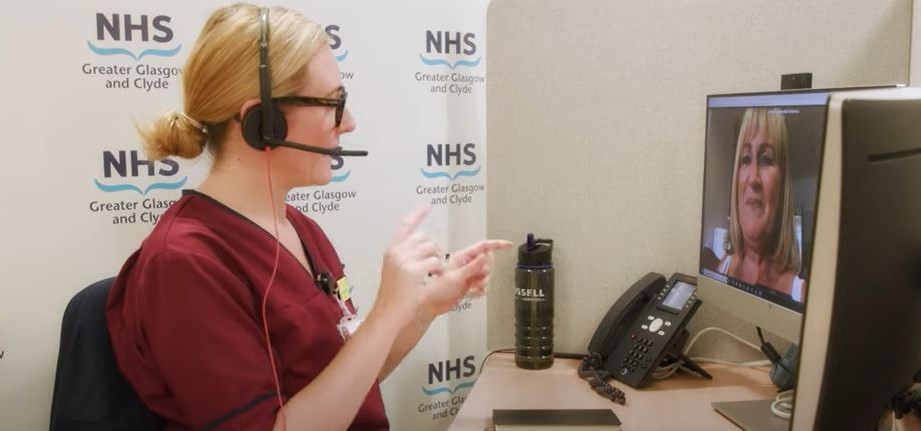
Almost all patients who sought help through a virtual A&E service would use it again if they needed advice, care or support with their health, a survey has revealed.
NHS Greater Glasgow and Clyde’s Flow Navigation Centre (FNC) provides direct access to emergency care for those who think they might need to go to A&E, but do not have a life-threatening condition.
Patients can access the service through NHS 24 by dialling 111, and they will be given a video or telephone consultation with a nurse or doctor from the comfort of their own home rather than having to travel to hospital and wait to be seen.
If an in-person exam or treatment is required, they will be given a scheduled appointment at a Minor Injuries Unit (MIU), other appropriate specialist service, or a planned arrival time at A&E if this is the right service to access.
An automated patient survey asks FNC users for their views immediately after they’ve contacted the service.
Over the past year, 4,226 patients responded to the survey, with 98 per cent saying they would use the service again if they needed advice, care or support with their health.
One person responded: “Being able to have a video call and show my injury was a lifesaver.
“She put my mind at ease straight away and gave me excellent care and advice.”
Another told how they were “more comfortable at home instead of waiting at A&E” and that the FNC organised a timed appointment at a MIU for them.
And a parent said the virtual A&E had “made it a lot easier” for their family as one of their children was “examined by a healthcare professional without having to sit in A&E for several hours”.
The most common reason for contacting the FNC, according to those who responded, was injury (95 per cent of cases).
The virtual A&E was used by more than 20,000 people last year, with less than a fifth going on to attend a physical emergency department.
Other comments recorded by the anonymous survey include:
- “Very patient and engaged consultant, explained his conclusions and advice thoroughly.”
- “The video call offered me the opportunity to show (my) injury and felt it was more efficient than attending a hospital to wait long periods of time. Doctor was very reassuring and offered clear detail.”
- “More comfortable at home instead of waiting at A&E, and a timed appointment for minor injuries.”
- “Didn’t have to leave home and wait in hospital. Able to speak with a specialist who answered all questions.”
In further feedback captured by the Care Opinion platform, which allows patients to share their experience of health or care services across the UK, one person told how they contacted the FNC after they fell and twisted both their ankles.
They said: “Called 111 and was then called an hour later and given a video appointment within the next hour.
“The video consult process was really simple and consultant checked things out via video and was given a timed appointment at clinic same day.
“Absolutely fantastic service. Everyone professional and friendly.
“I think perhaps the key thing was I was able to keep ice/elevation which would not have been possible if I waited in A&E instead.
“Hoping I never need it again but would absolutely recommend this option.”
NHSGGC aims to ensure patients are given the right care, in the right place, to free up capacity in physical emergency departments for those with the most urgent need.
The health board’s virtual pathways are designed to help reduce bottlenecks at A&E, improve flow throughout hospital wards and give patients a better experience.
As part of its ABC winter campaign, NHSGGC is encouraging people to be aware of the best places to get help if they or someone they know needs it:
Ask yourself: Do I need to go out? For information on keeping yourself well and treating minor illnesses and injuries from home, go to NHS Inform or download the NHS24 app.
Be aware: There is help for many conditions right on your doorstep. Your local GP, pharmacy, dentist or optician offer a range of services.
Call 111: If it’s urgent, or you’re not sure, call NHS24 on 111. They’ll make sure you get the help you need.
Ed Pool, Lead Advanced Nurse Practitioner and Clinical Service Manager with the Flow Navigation Centre, said: “Our virtual A&E allows thousands of patients to access emergency care without having to attend hospital.
“The FNC is one of a number of virtual pathways which are helping patients get seen and treated faster, and the response from those who have used it has been overwhelmingly positive.
“Pressure on our hospital sites remains at an all-time high but the FNC is having a significant impact as it diverts those who may have otherwise presented at a physical A&E to an appropriate service for their needs.
“This will play a key role in ensuring A&Es are available to those with the most urgent need, and we would continue to urge any patient who thinks they need to come to A&E to consider using this service and other urgent care provisions such as pharmacies, GPs, and the NHS Inform website.”
More information about the virtual A&E Flow Navigation service is available here.
